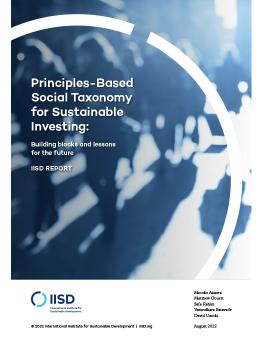
Principles-Based Social Taxonomy for Sustainable Investing
IISD developed a social taxonomy of business activities for a client country. It is based on the specific social and economic development vision and priorities of the country and aligned with international norms and best practices. Section 1 summarizes the context and construction of the social taxonomy as well as the lessons learned by IISD. Section 2 provides the actual social taxonomy proposal that was delivered to the client country.
The IISD designed a social taxonomy (system of classification) of business activities that promote social good and social governance improvements, both inspired by international norms and good practices, which were turned into minimum threshold-level activities that must be met for the user of the social taxonomy to assess its levels of contributions. The taxonomy has two sets of broad guiding principles (GPs): GP1 on promoting overall social well-being (enhancing positive social impacts) and GP2 on enhancing respect for human rights and enhanced company conduct (through company-level governance improvements on social issues).
The minimum threshold-level activities are a prerequisite for the application of GP1 and GP2. The threshold refers mostly to social safeguards, but also to minimum environmental safeguards, in an effort to create reference points between the social and environmental taxonomy and promote an integrated approach to achieving social and environmental sustainability.
To these foundational principles, IISD added a progressive system of implementation assessment that is designed to help companies move from a state of being out of compliance with domestic law to achieving international good practice, over time and at their own pace, using a colour-coded system.
For the dominant sectors in the client country, such as construction and real estate; utilities and infrastructure; finance and financial services; extractive; technology and telecommunications; education; healthcare; agriculture; and cross-sectoral activities, the taxonomy provides illustrative qualifying business activities that can contribute toward GP1 or GP2.
Participating experts
You might also be interested in
Integrating Gender Considerations in Green Bonds
This brief focuses on how to scale up gender-smart financing through mainstreaming gender considerations in all-new sustainable bond issues.
What Will Happen at COP 29?
Talks at the 2024 UN Climate Change Conference (COP 29) will range from defining a way forward on finance through a new collective quantified goal (NCQG) to mitigation, and loss and damage. Ahead of negotiations in Baku, IISD’s Earth Negotiations Bulletin Team Lead Jennifer Bansard examines the agenda and breaks down what to watch as eyes turn to Azerbaijan.
Border Carbon Adjustment Mechanisms and Impacts on Vietnam
This report consolidates, analyzes, and presents views and perspectives of stakeholders from Vietnam on border carbon adjustment (BCA) schemes to contribute to the global debate on BCA good practices.
The United Kingdom's Strategy for Carbon Border Adjustment in a Changing Global Landscape
This report consolidates, analyzes, and presents views and perspectives of United Kingdom stakeholders on its proposed Carbon Border Adjustment Mechanism (CBAM) to contribute to the global debate on international principles and best practices for national border carbon adjustment schemes.